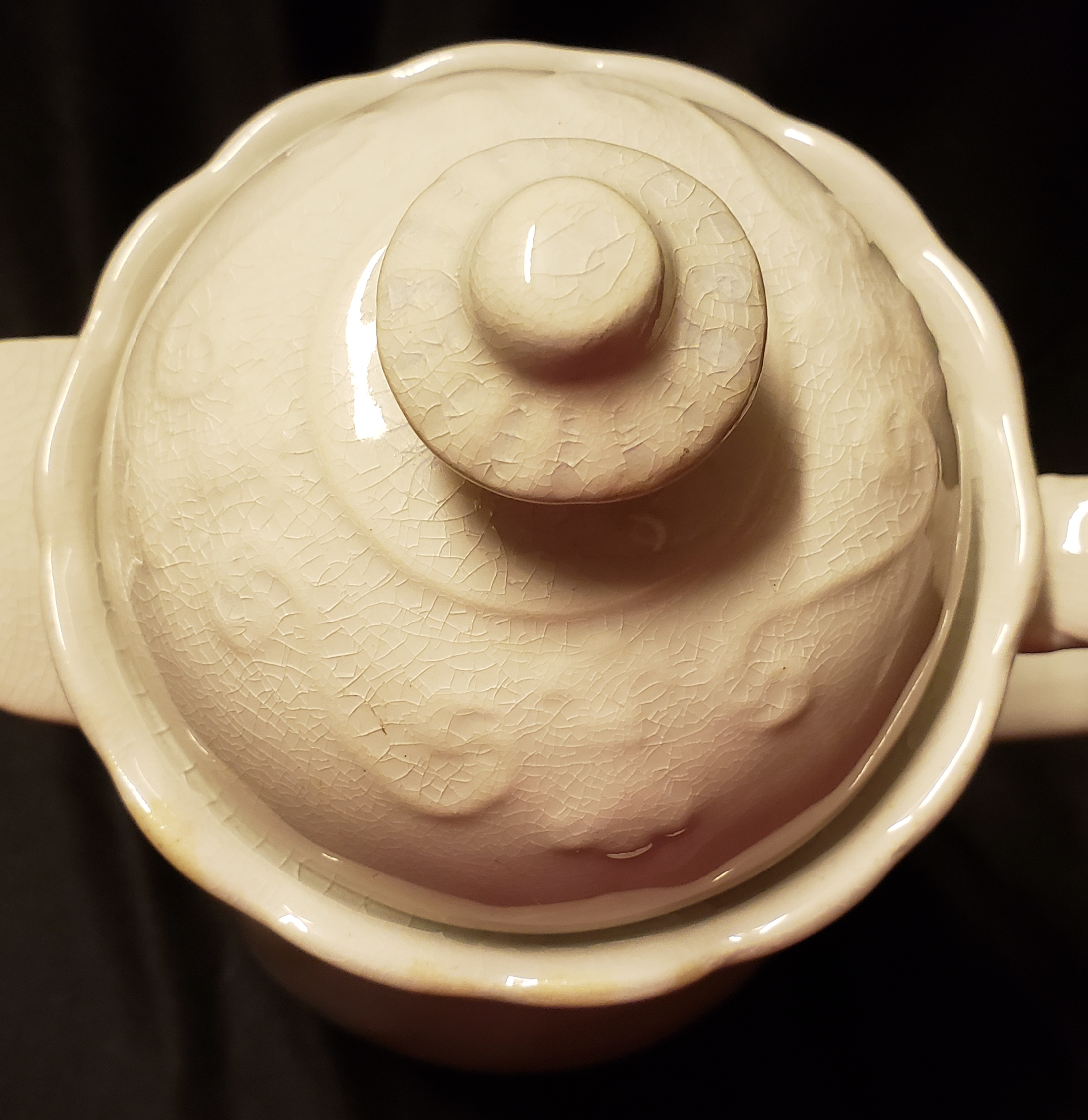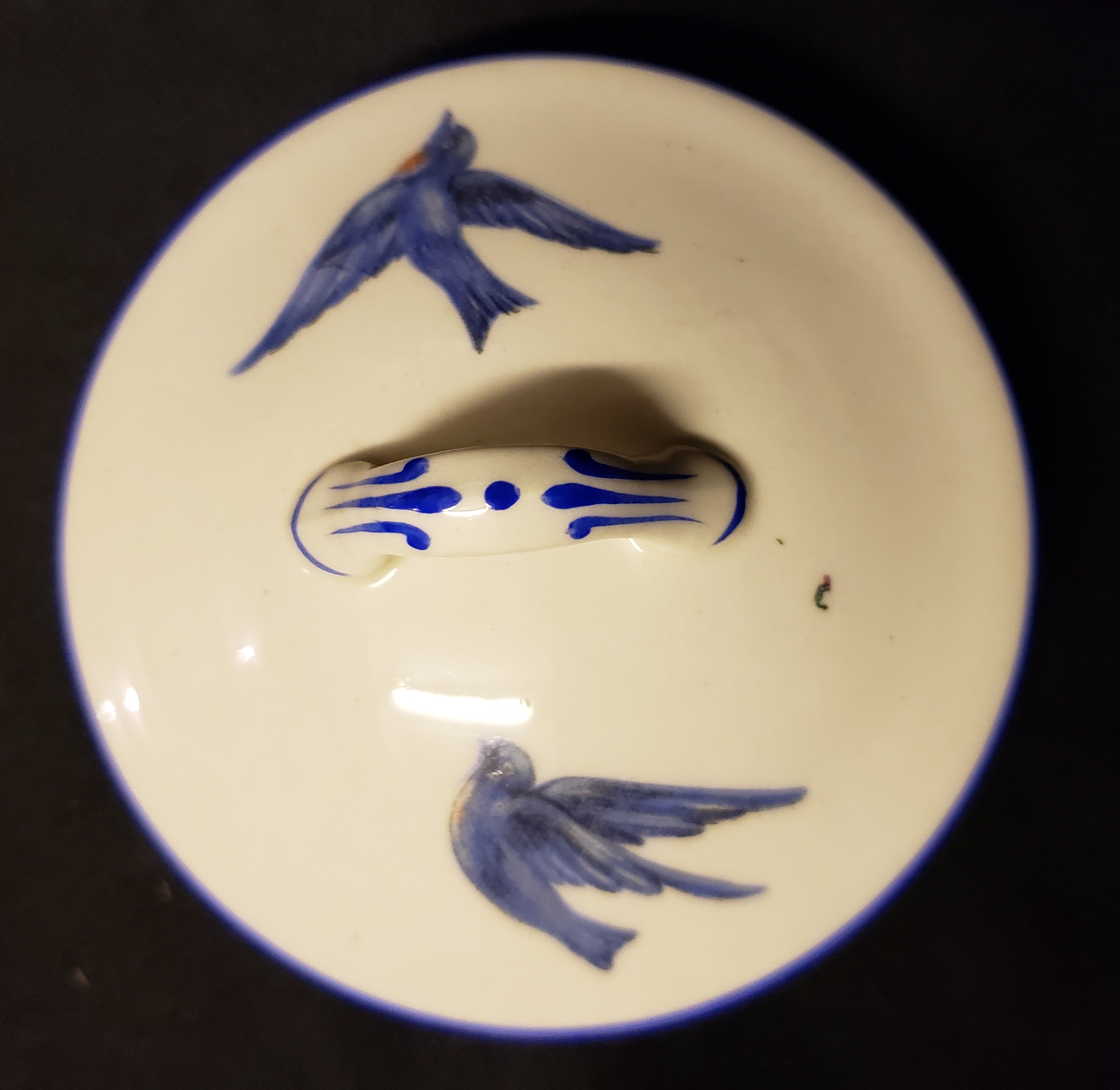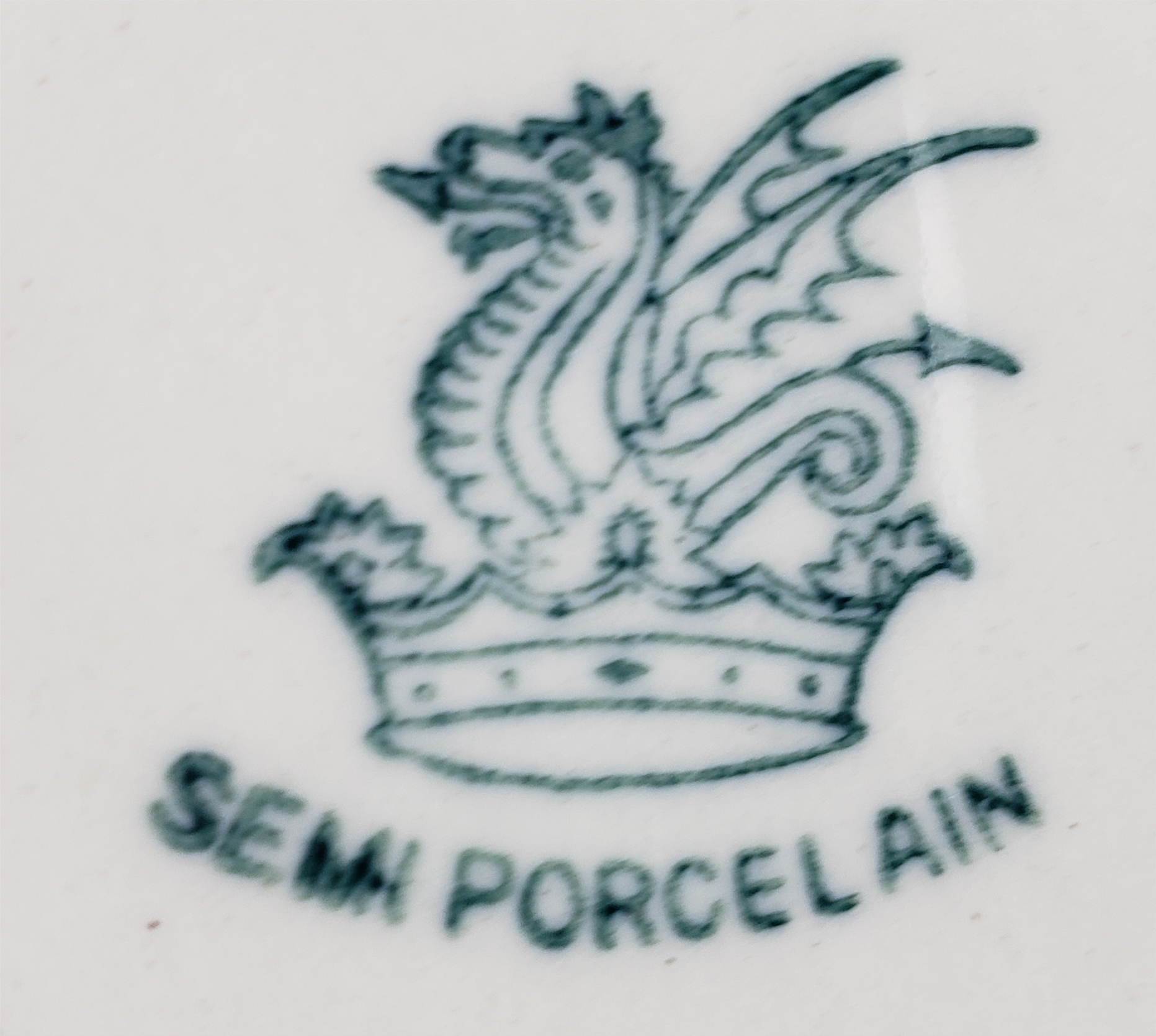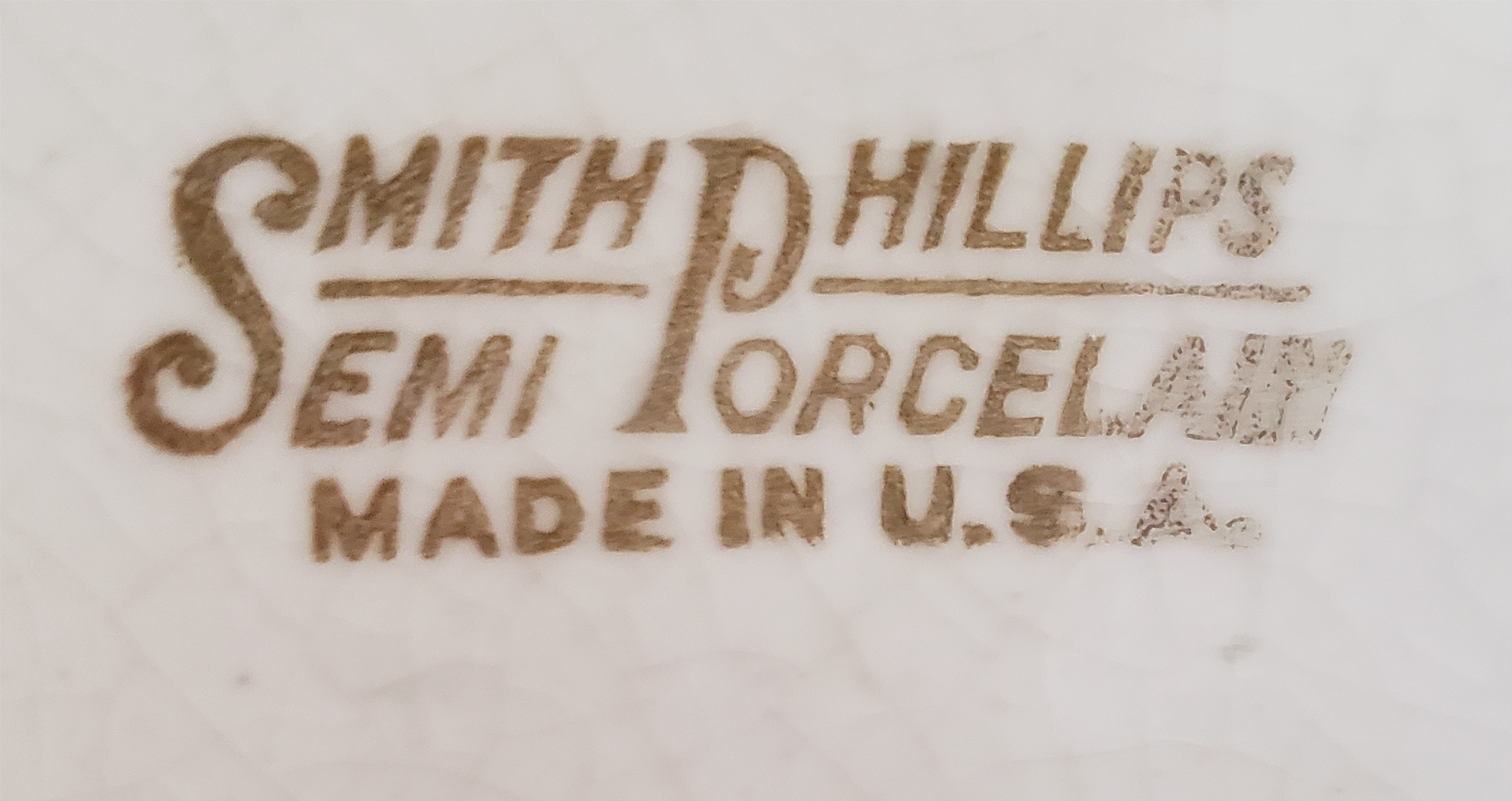Gallery ~ 3
Pioneer Pottery Company (Wellsville)
TITLE: Imperial
MAKER: Pioneer Pottery Company (Wellsville)
DATE: 1884-1900
COLLECTION: Museum of Ceramics/Ohio History Connection H560
George Morley left the company of Morley, Godwin and Flentke in 1878 forming a partnership with Harmar Michaels and I. B. Clark to establish a whiteware plant in Wellsville. The two kiln plant, Pioneer Pottery, was not as successful as other potteries in the district. In 1884, Morley resigned from the company to relocate to East Liverpool. The plant struggled but expanded to six kilns. However, in 1890 the business went into receivership. By 1900 the business officially closed. (Calhoun, 2020).
Tea Triva:
Reading tea leaves is considered an artform. It is called tasseography: “tasse” or “tass” is an Arab root which means small cup or goblet. Tea leaf reading dates to ancient times and is a tradition found in many cultures. The reader interprets the patterns left by the remnants in the cup to foretell the future. Reading may also be done with coffee grounds and wine remnants. (Kenna, 2021).
Pioneer Pottery Company (East Liverpool)
TITLE:
MAKER: Pioneer Pottery Company (East Liverpool)
DATE: 1935-1958
COLLECTION: Museum of Ceramics/Ohio History Connection HC696
Tea Trivia:
Although not a true tea, herbal teas are treated as such. Many plants used to produce herbal teas are native to the United States or are commercially cultivated, such as peppermint and spearmint which is grown in the Pacific Northwest. (United, 2017).
In 1935, George Singer, Albert Pelley and Grant Stover opened the Pioneer Pottery in East Liverpool. The ware, comprising tea sets, florist ware, and art ware, was distributed through The Pearl China Pottery Company, an outlet owned by Singer and Stover. The Pearl China Pottery Company outlived the Pioneer Pottery and continued to distribute ware for many of the other local potteries. (Gates, 2009).
Knowles, Taylor and Knowles (K. T. & K)
TITLE: Ironstone
MAKER: Knowles, Taylor and Knowles Company
DATE: 1880-1890
COLLECTION: Museum of Ceramics/Ohio History Connection H1397_002
Probably a child’s tea service due to the small size.
The original partners in the Knowles, Taylor and Knowles Company were Isaac Knowles, John Taylor and Homer Knowles. The Pottery produced Rockingham, yellowware, and ironstone (granite) ware. It is best known for Lotus ware. The company was in business from 1854 to 1931. In 1929, the company merged with several others to form the American China Corporation. The company did not survive the Great Depression. (Gaston, 1996; Gonzalez, 2020).
TITLE: Britannia Lid
MAKER: Knowles, Taylor and Knowles Company
DATE: 1872-1890
COLLECTION: Museum of Ceramics/Ohio History Connection
An early example of K. T. & K. ironstone ware. The pottery, Knowles, Taylor and Knowles was founded in 1854 by Isaac Knowles, a cabinet maker and carpenter, and Isaac Harvey. The company began making Rockingham and yellowware, and later made ironstone and granite ware. Harvey left the company in the 1860s. In 1870, Isaac Knowles brought his son, Homer, and son-in-law, John N. Taylor into the company establishing the legacy of K. T. & K. The one kiln, 1854 pottery developed into one of East Liverpool’s largest and longest surviving potteries. It joined the American Chinaware Corporation in 1929. The Great Depression hit hard on the struggling firm and it closed within two years. (Gates, 2009). The company would relocate to California.
TITLE:
MAKER: Knowles, Taylor & Knowles Company
DATE: 1905-1929
COLLECTION: Museum of Ceramics/Ohio History Connection H4112
Tea Trivia:
The Tea Horse Road was a system of caravan trails meandering through the mountains of Sichuan, Yunnan and Tibet in Southwest China. It was a popular tea trade route which connected China and South Asia. From the 6th century into the 20th century traders walked the path from the provinces to trade their tea for Tibetan ponies. (Kelly, 2021).
TITLE: Novada
MAKER: Knowles, Taylor & Knowles Company
DATE: 1885
COLLECTION: William and Donna Gray
A bold Moss Rose motif. Moss Rose was a very popular motif during the 19th Century.
TITLE: Niana Cinderella
MAKER: Knowles, Taylor & Knowles Company
DATE: 1900-1920
COLLECTION: William and Donna Gray
In a 1914 edition of Crockery and Glass Journal it is remarked that Knowles, Taylor and Knowles were introducing their Niana plain shape to the “Western trade” and that it had met with remarkable success. (Company, 2020).
TITLE: Rutland
MAKER: Knowles, Taylor & Knowles Company
DATE: 1890-ca 1907
COLLECTION: William and Donna Gray
In 1899, when Knowles, Taylor and Knowles was operating four pottery plants with a capacity of 30 kilns, a fire destroyed the newest, an eight kiln pottery. At the time the company was the largest manufacturer of pottery in the East Liverpool district. K. T. & K. rebuilt the pottery adding two kilns. (An Artisan, 1934).
TITLE: Kate Greenaway
MAKER: Knowles, Taylor & Knowles Company
DATE: 1900-1920
COLLECTION: William and Donna Gray
Child sized teapot with Kate Greenaway illustrations. Kate Greenaway was a popular children’s author of Mother Goose stories and nursery rhymes.
TITLE: Ironstone
MAKER: Knowles, Taylor & Knowles Company
DATE:
COLLECTION: William and Donna Gray
Vodrey and Brother Pottery
Tea Recipe:
Iced London Fog: Bring 4oz water to a boil, place 1 teabag of Earl Gray tea (or 1 Tbs loose tea) and 1/2 tsp dried lavender in a tea ball infuser or loose leaf teapot. Pour 1/2 cup boiling water over leaves and steep 10 minutes. Fill a 10-ounce glass with ice. Strain the hot tea over the ice. Add 3-5 drops liquid stevia, 1/2 tsp pure vanilla extract, and 1/4 cup cashew or almond milk then stir. Taste for sweetness and add stevia if needed. Drink immediately. (Danielle, 2020).
TITLE: Ironstone
MAKER: Vodrey and Brother Pottery
DATE: 1876-1896
COLLECTION: Museum of Ceramics/Ohio History Connection H590_002 & H590_001
Jabez Vodrey and his family emigrated from Staffordshire England. There is evidence that, as early as 1827, Jabez established the first commercial pottery west of the Appalachian mountains in Pittsburgh, Pennsylvania. The pottery was known as Vodrey and Frost and they made Rockingham and yellowware. Following the Civil War, many potteries migrated to making whitewares such as ironstone. In 1847, following several years in the pottery industries in Kentucky and Indiana, Vodrey and his family moved to East Liverpool, Ohio where he established the first of the Vodrey potteries on Fourth Street. After his retirement in the mid 1850s, his sons, James, John, and William established the Vodrey Brothers Pottery on Fourth and College Streets in an old burned-out Catholic Church. In the 1930s, when the pottery was torn down, the remains of the church were still evident as part of the structure.
Following the deaths of Jabez Vodrey in 1861 and of brother, John, in 1864, during the Civil War, James and William continued the pottery as Vodrey and Brother. (Witt, 2019).
TITLE: Whiteware
MAKER: Vodrey and Brother Pottery
DATE: c. 1867
COLLECTION: Museum of Ceramics/Ohio History Connection H584_002
William Vodrey maintained a meticulous recipe notebook (held in the Museum of Ceramics archives), that includes recipes for the different types of china and glazes produced by the Vodrey Brothers Pottery. William H. Vodrey also maintained the notebook, making comments on his father’s work and clarifying the information included. On June 18, 1871, he included two glaze recipes sent by Daniel Vodrey from Burslem, England that were “represented to be the best of the kind now in use in the Staffordshire potteries.” (Vodrey, 1839).
Tea Trivia:
There is a constellation called “The Teapot!” Sagittarius, also referred to as the centaur, is thought to resemble a teapot because of its boxy appearance and two extensions similar to a handle and spout. Some have noted that “the Milky Way appears to be rising out of the spout like steam.” (Peterson, 2018). Read about and view an image of “The Teapot” constellation.
TITLE: Palissy
MAKER: Vodrey and Brother Pottery
DATE: 1890-1896
COLLECTION: William and Donna Gray
The Vodrey and Brother Palissy line was produced from 1890-1896 and was named for the original pottery known as the “Palissy Works.” (Antique, 2020).
Tea Trivia:
“Flushes” are the top one to two inches of growth found on a mature tea plant. These are the only leaves picked from it and they grow within seven to 14 days during the season. Each plant will have three flushes in a year, The first flush produces the best tea. (Kenna, 2021).
Tea Trivia:
Tea, as well as coffee, may seem to have a different taste when served on airplanes. The boiling point of water is 18 to 20 degrees lower when at high altitudes due to air pressure and this may affect the flavor. (Chamberlain, 2019).
TITLE:
MAKER: Vodrey and Brother
DATE: 1876-1896
COLLECTION: William and Donna Gray
TITLE:
MAKER: Vodrey and Brother Pottery
DATE: 1896-1920
COLLECTION: William and Donna Gray
Tea Trivia:
The British Standards Institute regularly releases a guide with tips on the best ways to prepare and serve tea. It includes all the specifications for making the perfect cup of tea depending on what kind of teapot or tea you are using. A standard steeping time is reportedly six minutes. (Myers, 2017).
William Bloor and Company
TTITLE: White Ironstone Chinese Shape
MAKER: William Bloor (attributed)
DATE: c1850
COLLECTION: Museum of Ceramics/Ohio History Connection H1436_001
This Chinese shape Ironware teapot has a handwritten note on the base that reads, “William Bloor. Loaned by Miss Neil/Morley.”
William Bloor is considered by many as a pioneer of the pottery industry in East Liverpool, second only to James Bennett. William Bloor first came to East Liverpool in the 1840s where, by 1853, there were 11 potteries employing approximately 387 workers. In 1849 or 1850, Bloor, along with his brother-in-law, William Brunt Jr., left East Liverpool to pursue his fortune in the California gold rush. They returned to East Liverpool in 1860 having spent at least three years working in the potteries in Trenton, New Jersey. On their return to East Liverpool they purchased a part of the Woodward and Blakely pottery and incorporated as William Bloor and Company. In 1862, Bloor once again left the area, to eventually return in 1875 as a partner in the Brunt, Bloor & Martin Company. (Calhoun, 2020).
Tea Trivia:
George Orwell has said: “Lastly, tea--unless one is drinking it in the Russian style--should be drunk WITHOUT SUGAR. I know very well that I am in a minority here. But still, how can you call yourself a true tea-lover if you destroy the flavour of your tea by putting sugar in it? It would be equally reasonable to put in pepper or salt. Tea is meant to be bitter, just as beer is meant to be bitter. If you sweeten it, you are no longer tasting the tea, you are merely tasting the sugar.” (George, 2021).
United States Pottery Works - William H. Bloor
TITLE: Parian Ware
MAKER: William H. Bloor / United States Pottery Works
DATE: 1861 - 1862
COLLECTION: Museum of Ceramics/Ohio History Connection H1428
In 1855, English potter, William H. Bloor joined James Taylor and Henry Speeler in Trenton, New Jersey. In 1849, Bloor had been making Rockingham and yellowware with William Brunt, Sr., in his East Liverpool pottery.
Bloor worked in Trenton until 1859 and then returned to East Liverpool, where he purchased part of the Phoenix Pottery where he made Rockingham, yellowware, and the city’s first ironstone ware. By 1861 he had established the East Liverpool Porcelain works, making fine porcelain and Parian ware, a first for the region. Financial difficulties and loss of labor during the Civil War forced Bloor to sell his pottery in 1862. (Goldberg, 2003).
Parian ware, developed in the second half of the 19th century, is a type of biscuit porcelain made to imitate marble. In its original forms it was left unglazed and white to show the beauty of the original piece and produced in statuary form. Later, a glaze was added to the piece with areas of relief left unglazed to highlight the design. The item was fired twice. The glaze was usually, but not always, blue. (About, 2020).
Smith-Phillips China Company
TITLE: Princess (Gold)
MAKER: Smith-Phillips China Company
DATE: 1909 - c. 1920
COLLECTION: Museum of Ceramics/Ohio History Connection HC111a
In the April 11, 1911 edition of the Crockery and Glass Journal it was noted that, “When the Klondike gold fever was on, Evas Sebring built a pottery a mile east of the pottery centre here, and called it the "Klondike " When the plant was bought by the Smith-Phillips China Co. the name stuck. Now the Post office Department established a post-office there, to be known as "Klondike, O." The name is especially appropriate, for the Smith-Phillips Co. are said to be using more coin gold than any other plant here.”
TITLE: Princess (Pink)
MAKER: Smith-Phillips China Company
DATE: 1901-1929
COLLECTION: William and Donna Gray
TITLE: Princess
MAKER: Smith - Phillips China Company
Date: 1918-1929
COLLECTION: Museum of Ceramics
The Smith-Phillips China Company was formed in 1900 when Josiah T Smith and William R Phillips purchased the French China Company building on Michigan Ave in the Klondike area of East Liverpool, after the Sebring brothers moved their business to Sebring, Ohio.
The company produced semi-vitreous (semi-porcelain) wares in plain and decorated styles. (Gonzalez, 2020).
Tea Trivia:
The United States is not known for tea production but there are at least three areas that commercially grow tea in the continental US. Bigelow Tea owns a commercial tea plantation in South Carolina. There is also a small tea-producing operation, owned by the Sakuma Brothers, in the Skagit Valley, Washington. Even less well-known than these two, is an Alabaman tea plantation called Fairhope Tea Plantation, run by Donnie Barrett. Tea is also grown in Hawaii. (United, 2017).
















































